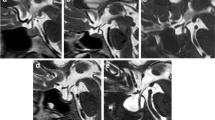Abstract
Purpose
Petrous apex meningocele (PAM) is an uncommon cystic lesion involving the petrous apex. The underlying cause of PAM may be related to chronic elevated intracranial pressure. The aim of the study was to explore the relationship between PAM and meningioma and between PAM and other intracranial hypertension findings.
Methods
Two hundred seventy-eight consecutive patients with meningiomas were retrospectively studied. Fifty age- and gender-matched controls were also enrolled in this study. The incidence of PAM, empty sella, tortuosity of the optic nerve, and hydrops of optic nerve sheath was evaluated. The maximum width, area, volume of each PAM, or Meckel’s cave and volume of meningioma were measured in controls and patients, separately.
Results
One hundred fifty-nine (57.19%) patients were detected with coexistent PAMs. One hundred twenty-five patients had bilateral PAMs, 34 had unilateral lesions, and the remaining 119 did not have PAM. Two subjects (4/50) had unilateral PAMs in normal controls. The maximum width, area, volume of PAM, or Meckel’s cave were significantly larger in the patients with bilateral PAM group than those in the unilateral PAM group, in the group without PAM, and those in control group (p = 0.000). The volume of meningioma was positively correlated with the PAM volume (r = 0.48). There was a positive correlation for the incidence between PAM and (1) empty sella (r = 0.901) and (2) tortuosity of the optic nerves and hydrops of the optic sheath (r = 0.825).
Conclusion
Coexistence of PAMs with meningiomas is not rare in incidence, and it suggests a potential role for chronically elevated intracranial pressure and disturbance of CSF circulation in their pathophysiology.




Similar content being viewed by others
References
Ranganathan S, Lee SH, Checkver A et al (2013) Magnetic resonance imaging finding of empty sella in obesity related idiopathic intracranial hypertension is associated with enlarged sella turcica. Neuroradiology 55:955–961
Kyung SE, Botelho JV, Horton JC (2014) Enlargement of the sella turcica in pseudotumor cerebri. J Neurosurg 120:538–542
Butros SR, Goncalves LF, Thompson D, Agarwal A, Lee HK (2012) Imaging features of idiopathic intracranial hypertension, including a new finding: widening of the foramen ovale. Acta Radiol 53:682–688
Bialer OY, Rueda MP, Bruce BB et al (2014) Meningoceles in idiopathic intracranial hypertension. AJR Am J Roentgenol 202:608–613
Lee SH, Choi H, Koh SH, Lee KY, Lee YJ (2013) MRI and ultrasonographic findings in idiopathic intracranial hypertension. Cephalalgia 33:139–140
Rohr AC, Riedel C, Fruehauf MC et al (2011) MR imaging findings in patients with secondary intracranial hypertension. AJNR Am J Neuroradiol 32:1021–1029
Moore KR, Fischbein NJ, Harnsberger HR et al (2001) Petrous apex cephaloceles. AJNR Am J Neuroradiol 22:1867–1871
Buetow MP, Buetow PC, Smirniotopoulos JG (1991) Typical, atypical, and misleading features in meningioma. Radiographics 11:1087–1106
Kim JH, Ko JH, Kim HW, Ha HG, Jung CK (2009) Analysis of empty sella secondary to the brain tumors. J Korean Neurosurg Soc 46:355–359
Saindane AM, Lim PP, Aiken A, Chen Z, Hudgins PA (2013) Factors determining the clinical significance of an "empty" sella turcica. AJR Am J Roentgenol 200:1125–1131
Fois P, Lauda L (2011) Bilateral Meckel's cave arachnoid cysts with extension to the petrous apex in a patient with a vestibular schwannoma. Otol Neurotol 32:e36–e37
Cho YJ, Kim HC, Kim YW et al (2014) Percutaneous access via the recanalized paraumbilical vein for varix embolization in seven patients. Korean J Radiol 15:630–636
Inamura A, Ideguchi M, Sadahiro H, Suzuki M (2012) Sphenoid ridge meningioma with increased intracranial pressure caused by venous congestion. Acta Neurochir 154:1945–1946
Kiroglu Y, Yaqci B, Cirak B, Karabulut N (2008) Giant arachnoid granulation in a patient with benign intracranial hypertension. Eur Radiol 18:2329–2332
Lee JH, Lee HK, Kim JK et al (2004) CSF flow quantification of the cerebral aqueduct in normal volunteers using phase contrast cine MR imaging. Korean J Radiol 5:81–86
Stark TA, McKinney AM, Palmer CS, Maisel RH, Truwit CL (2009) Dilation of the subarachnoid spaces surrounding the cranial nerves with petrous apex cephaloceles in Usher syndrome. AJNR Am J Neuroradiol 30:434–436
Alorainy IA (2007) Petrous apex cephalocele and empty sella: is there any relation? Eur J Radiol 62:378–384
Jakkani RK, Ragavendra KI, Karnawat A, Vittal R, Kumar A (2012) Bilateral petrous apex cephaloceles. Neurol India 60:563–564
Moore KR, Harnsberger HR, Shelton C, Davidson HC (1998) ‘Leave me alone’ lesions of the petrous apex. AJNR Am J Neuroradiol 19:733–738
Sallomi D, Taylor H, Hibbert J et al (1998) The MRI appearance of the optic nerve sheath following fenestration for benign intracranial hypertension. Eur Radiol 8:1193–1196
Isaacson B, Kutz JW, Roland PS (2007) Lesions of the petrous apex: diagnosis and management. Otolaryngol Clin N Am 40:479–519
Razek AA, Huang BY (2012) Lesions of the petrous apex: classification and findings at CT and MR imaging. Radiographics 32:151–173
Acknowledgments
We thank the anonymous reviewers for their helpful suggestions on the quality improvement of the present study. We also thank all individuals who served as research participants.
Author information
Authors and Affiliations
Corresponding author
Ethics declarations
Funding
This work was partially funded by the National Foundation of Natural Science of China (81471654) and Medical Science and Technology Research Foundation of Guangdong province (A2016136).
Conflict of interest
The authors declare that they have no conflict of interest.
Ethical approval
All procedures performed in studies involving human participants were in accordance with the ethical standards of the Guangdong General Hospital institutional Ethics Committee and with the 1964 Helsinki declaration and its later amendments or comparable ethical standards.
Informed consent
For this type of retrospective study formal consent is not required; however, informed consent was obtained from each subject in the control group.
Rights and permissions
About this article
Cite this article
Yang, WQ., Feng, JY., Liu, HJ. et al. Analysis of petrous apex meningocele associated with meningioma: is there any relation with chronic intracranial hypertension?. Neuroradiology 60, 151–159 (2018). https://doi.org/10.1007/s00234-017-1932-x
Received:
Accepted:
Published:
Issue Date:
DOI: https://doi.org/10.1007/s00234-017-1932-x




